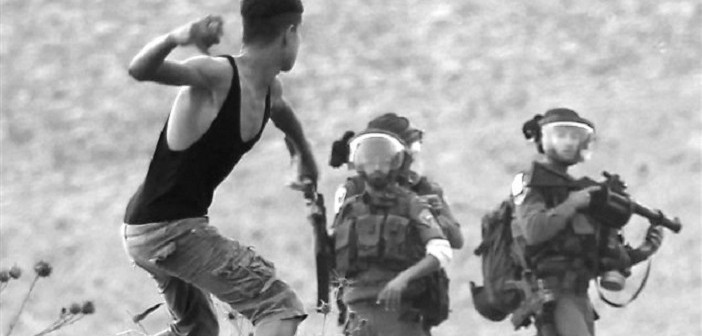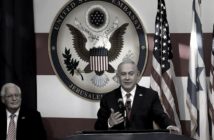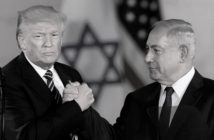Nir Hasson wrote a piece in Haaretz last week, titled “After years of calm, fear is dividing Jerusalem”. Most of the headlines that followed were of a similar nature, accompanied by recurring phrases which are quite detached from the reality on the ground, such as “U.N. leader urges calm amid escalating Palestinian-Israeli violence”—as if we are talking about an intractable conflict between two equal sides. The implication that recent events interrupted a period of calm belies the real context in which these events are taking place. As eloquently put by Lamis Andoni, the Al-Jazeera’s analyst and commentator on Middle Eastern and Palestinian affairs: “What we are witnessing across the West Bank and Gaza Strip is not another ‘cycle of violence’ that needs to be de-escalated but a continued national liberation struggle that needs to be fulfilled.”
Repeated Israeli incursions into the al-Aqsa Mosque Compound have triggered what has been referred to as the “third intifada”—which is a debatable term in and by itself, and slightly irrelevant given the current context. Yet, Palestinian protesters who took to the streets across the occupied West Bank, Gaza Strip, Jerusalem, and present-day Israel, were collectively calling for an end to Israel’s on-going and decades-long occupation. It is therefore important to note, as stated by the researcher in Middle East policy at University of Cambridge Nur Arafeh, that “the framing of these events as a religious war not only ignores the reality of the power imbalance between the colonizer and the colonized, but also fails to address the history and context in which the recent events have unfolded”. The present uprising predates October 2015, and has been fueled by Israel’s deliberate and long-standing policy of creating irreversible facts on the ground as a way of asserting its colonial power.
Violence: inherent feature of Israeli occupation
Between the beginning of 2015 and the time of writing, 82 Palestinians had been killed by Israeli forces and settlers, according to Al-Haq’s documentation.
In June of this year, there were approximately 5,850 Palestinian political prisoners held in Israeli prisons and detention centers, including over 480 held under administrative detention (without charge or trial)—an illegal practice under international law. Following the occupation of the West Bank, Gaza Strip and East Jerusalem in 1967, over 700,000 Palestinians have been detained, almost 20% of the total Palestinian population. Of particular concern is the number of Palestinian minors held in Israeli jails. Since 2000, more than 8,000 Palestinian youth have been arrested across the Occupied Palestinian Territories (OPT), often taken in the middle of the night without warning. According to data provided by Defense for Children International-Palestine (DCIF), around 500-700 Palestinian children are arrested each year, many of whom are subjected to ill-treatment and torture during arrest, transfer and interrogation.
Since the beginning of October 2015, however, Israeli forces have been pursuing a policy of mass arrests in the West Bank, Jerusalem and 1948 territory. Addameer statistics show that from the 1st until the 25th of October, 942 Palestinians were arrested, including 144 children. The total number of Palestinian political prisoners has thus increased from 5,850 in June 2015 to 6300. Israeli authorities have also issued 60 administrative detention orders since the beginning of the month.
Meanwhile, 48,488 Palestinian homes and other essential Palestinian owned-structures and facilities have been demolished by Israeli authorities since 1967—in direct contravention of Israel’s human rights obligations and the laws of occupation. 450 houses have been demolished in 2015 alone, forcibly displacing around 514 Palestinians. Israel’s punitive house demolition policy, which represents a policy of displacement, has been often used to quietly transfer Palestinians out of the country, and has been recently renewed to target the houses of alleged Palestinian attackers—leaving their families homeless.
It is just one form of collective punishment with the aim of deterring Palestinians from resisting the occupation, and confining them to a series of tiny, enclosed and non-viable cantons, divided and locked into disconnected ghettos. The publically stated discriminatory planning, zoning and building policies, codified in the Israeli Planning and Building Law of 1965, are particularly common throughout occupied East Jerusalem. They are driven by a geopolitical agenda; promoting the expansion of East Jerusalem’s Jewish population, at the expense of reducing its Palestinian residents. Under Israeli zoning policy, for instance, Palestinians can build in just 13% of East Jerusalem.
In addition to punitive home demolitions, the Israeli Ministry of Interior revoked the permanent residency status of 107 Palestinian residents of Jerusalem in 2014, in addition to the 14,561that were revoked between 1967 and 2011 (JCSER latest statistics). During a security cabinet meeting two weeks ago, Netanyahu proposed the possibility of revoking residency status from Palestinian Jerusalemites living within Jerusalem’s municipal borders but behind the wall. According to human rights groups, the aforementioned proposal could affect the residency right of over 80,000 people, almost a third of Jerusalem’s Palestinian population. This would entail the revocation of all social benefits and rights provided by the National Insurance Institute, such as health insurance.
Culture and Sports Minister, Miri Regev, went as far as suggesting the revocation of citizenship of “suspected assailants’ relatives”, in an attempt to banish alleged attackers’ families from Jerusalem—which constitutes another form of collective punishment. Interior Minister, Silvan Shalom of the ruling Likud party, said: “We must vomit the bloodthirsty murderers from among us”, as he submitted consultation requests to revoke citizenship and residency status of Palestinians who have been suspected of carrying out stabbing attacks, confiscating the land upon which their demolished houses were built, and denying social benefits to their families.
All these measures, taken over the last few weeks, aim at cutting off Palestinian neighborhoods with an Arab majority from Jerusalem—as part of Israel’s comprehensive structural plan to further Judaize the city. Jabal al-Mukaber, Silwan and al-Issawiya neighborhoods, which have been sealed off completely by Israeli forces, are three cases in point. As of October 18, there were 35 internal checkpoints and concrete roadblocks placed throughout East Jerusalem, positioned at various entry points to Palestinian villages and neighborhoods, sometimes completely preventing the passage of ambulances and vehicles (according to Israeli human-rights NGO B’Tselem). Last week, Huda Darwish, a 65-year-old Palestinian woman died after being held up for an hour at a new checkpoint outside her neighborhood of al-Issawiya.
The recent and more intense attack on Al-Aqsa Mosque Compound in the old city of Jerusalem by Israeli forces and settlers, is the latest in a history of similar episodes of settler violence against Palestinians and their property. The murder of Ali Dawabasheh, an 18-month-old Palestinian boy, burnt to death by Israeli settlers in July 2015—which according to many is behind the current outburst—is part of the on-going trend of settler violence, intensified by the “Price Tag” policy and institutionalized impunity. Between 29 September and 11 October, Al-Haq documented at least 42 incidents of settler attacks against Palestinians across the OPT.
This finally brings into question Israel’s extra-judicial executions, and their adoption of a “shoot-to-kill” policy, particularly “in circumstances that appear not to have posed an imminent danger to them or to others”, as stated by Adalah, a legal centre for Israel’s Arab minority. According to numbers provided by the Palestinian Red Crescent, Israel has injured 6,178 Palestinians across the OPT since the beginning of the month, 386 of whom by live ammunition, mainly for throwing stones.
The root of the problem is the Israeli occupation
After twenty-two years of failed peace process, with the Palestinian Authority (PA) acting as a subcontractor to the occupation, young Palestinians are taking matters into their own hands.
Against this background, and given the asymmetric nature of the conflict, it becomes increasingly important to situate the recent youth-driven uprising within the context of Israel’s (decades-long) deliberate and systematic policies of occupation, settler-colonialism and ethnic cleansing—all of which aim at altering the demographic composition, geographic nature, and the historical and cultural features of the OPT, particularly in and around Jerusalem. It is thus important to be aware to what extent a discourse which frames recent events as violence interrupting a period of calm in fact contributes towards keeping Israeli colonial practices alive by ignoring the root causes of the problem.
It seems, however, that the Israeli violence brimming beneath the calm façade, violence felt in the day to day lives of Palestinians, has not been worthy of recognition.





